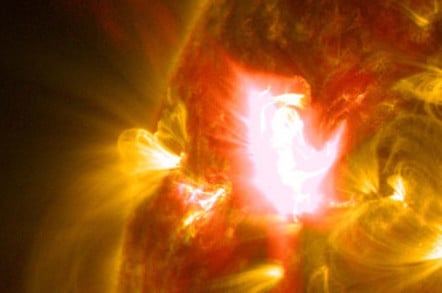'Graceful' solar flare erupts from surface of Sun – NASA vid
Mid-level radiation explosion captured by SDO

Video NASA's Solar Dynamics Observatory has released a video of a "graceful" solar flare erupting out of the Sun's surface on 2 April.
The flare shows up on the Sun as sudden swirls of brightness, indicating the bursts of radiation in an M6.5 class eruption.
"“The image shows the flare in a blend of two wavelengths of extreme ultraviolet light: 131 Angstroms and 171 Angstroms, colourised in yellow and red, respectively,” NASA explained.
M-class flares are 10 times less powerful than the most intense flares, labelled X-class, which could theoretically cause a lot of damage on Earth. While a flare's harmful radiation can't get through our planet's atmosphere to affect us on the ground, it could disturb the atmosphere enough to disrupt GPS and communications.
It's when solar flares come alongside coronal mass ejections that humanity really has to watch out. The two events don't have to happen together, but they often do. In a CME, fluctuations in the Sun's magnetic fields cause a large portion of its surface to explode, shooting billions of tons of particles out into space in a huge magnetic shockwave. If the Earth was hit by one big enough, its own magnetic field could be unpredictably disrupted, frying electronics along with communications and navigational systems.
A solar flare's strength is counted on a scale as well as by letter, so an M2 class eruption is twice as intense as an M1, an M3 is three times as intense and so on, making last week's eruption a mid-level one. ®








 User Center
User Center My Training Class
My Training Class Feedback
Feedback











